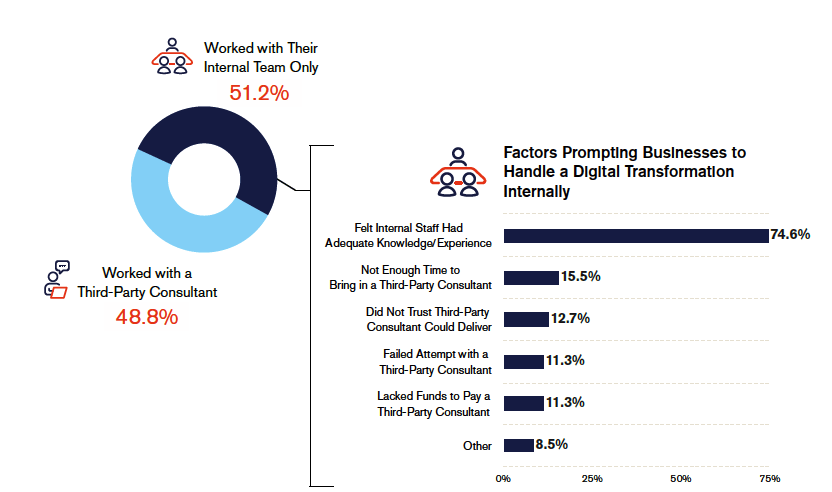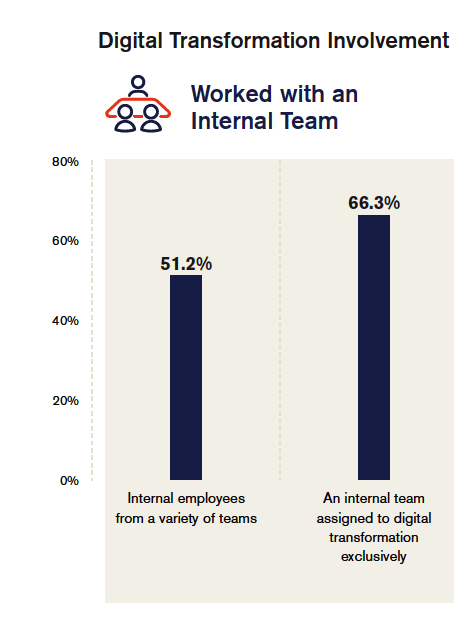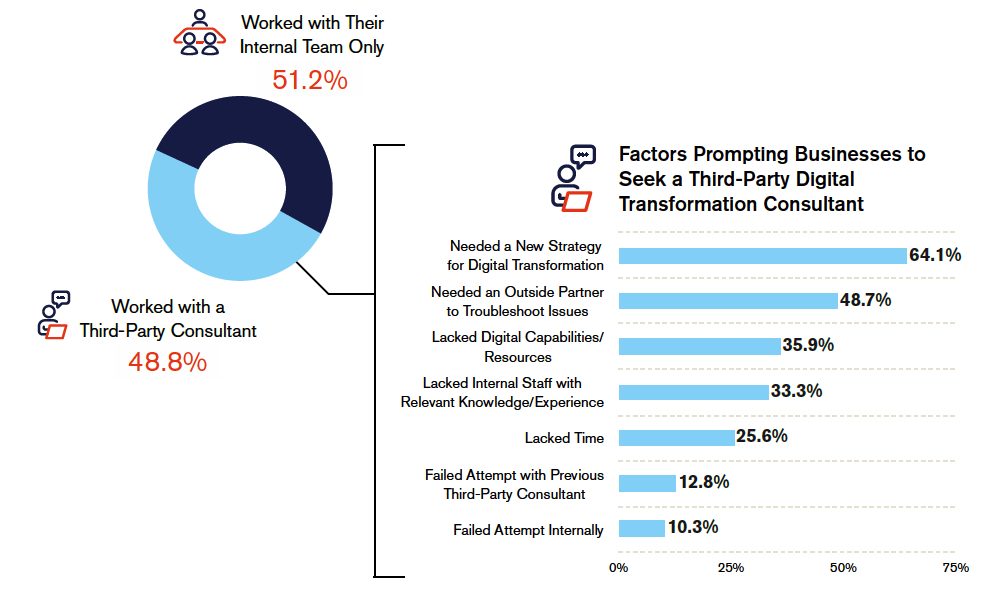Welcome to Part 2 of our series where we deep dive into the findings from our recently published report, The State of Digital Transformation.
In Part 1, we assessed the importance of staying power and how leaders benefitted from not only commencing Digital Transformation but also committing to an active strategy. So with that clarified, and your trajectory propelling you forwards, Part 2 outlines key findings when considering what type of team structure you should be building to ensure success.
Internal Responsibility vs. Working With a Third Party
Ultimately there is no right or wrong way to approach your team setup as every business is different. If you feel you have the team and the relevant skillsets to achieve your goals then why rely on a third party for support? Similarly, if you don’t have the internal skillsets, it may be better to look externally for support. Having said that we’ve been able to identify some significant trends having spoken to industry leaders about their approaches—something we will dissect later in this piece. But first, let’s look at the context of the internal vs. external debate.
Looking Internally?
Over half the businesses we spoke to in this study relied solely on their internal team to implement transformations. The reason? Twenty-five percent of the responses covered a variety of answers such as a lack of trust, a lack of money to hire third parties, or a lack of time needed to get others up to speed. However, the number one reason for using internal resources was they believed their existing team had the knowledge and experience to pull it off.


Looking Externally?
In Part 1 of the series, we looked at the barriers to digital transformation with ‘a lack of internal expertise’ being a top factor in deciding whether to progress or not. So why not consider third-party support?
Nearly half of the businesses in this study used a third-party consultant in some capacity to assist with their transformation. Why is this? Many of the responses revolved around a lack of resources, or a lack of experienced staff; however, the majority of responses focused on the additional guidance and troubleshooting support a consultancy can provide. Digital transformation isn’t a small undertaking, so bringing in specialist consultants, whilst it may be deemed more costly, is certainly highly cost-effective.

The Benefits of Third Parties
When talking to leaders we found that, regardless of the transformation stage, whether it is in progress or completed, those who engaged a third-party consultant were more successful with their transformation than those that relied exclusively on their internal teams. Here are some figures to exemplify the point:

As demonstrated, when relying on internal teams, 20% of those that were mid-transformation rated their efforts as unsuccessful whereas those that had engaged a consultancy classified their efforts as unsuccessful in 8.7% of cases.
It’s also interesting to see that 83% of those that had already completed their transformation and involved a third party were the most satisfied segment of all. Taking this a step further, we asked leaders for more insight as to how third parties helped them achieve their goals:
- Eighty-five percent of businesses that involved a third party had a high level of digital maturity, 11% higher than businesses that used only internal staff.
- In addition to profitability and online sales, annual revenue and awareness also improved by 4% points over those that focused on internal means.
- The majority of companies that deemed their transformation to be ‘Highly Successful’ used third parties.
- Despite the widespread success, mid-size businesses were the obvious benefactors of an external strategy; 55% of such companies used a third party and 90% deemed their efforts a great success.
Specialized or Large Third Parties?
So, you’ve committed to a third party, but what type of consultancy do you go for? A large generalist consultancy or a smaller specialist boutique? As it turns out, 100% of companies that hired a highly-skilled boutique, specialist firm as opposed to a larger generalist consultant, categorized success as highly successful. Often the assumption is that smaller boutiques don't have the resources you require when the reality is often the total opposite.
What is Right For You?
There is plenty to digest and ultimately, there are a multitude of factors to consider when planning a transformation. One thing we can say for certain is that everyone who completed a digital transformation, regardless of strategy, saw a greater performance than prior to the transformation.
What do our findings tell us is the optimal approach? Simply put, businesses that decided to opt for the support of a third-party consultant with a specialist skillset were most satisfied with business performance post-transformation.
If it’s a fresh perspective you are looking for, we’d be happy to chat. You can contact us immediately for a complimentary consultation.
Part 3 Preview
In Part 3, we’ll round out the series by offering our concluding thoughts, contextualizing the core findings, and highlighting why it is critical for businesses to consider a new Digital Transformation strategy to safeguard future success.
If you missed our webinar with our partners at Hinge Research covering the full research findings, please view it for free in its entirety on our YouTube channel.


